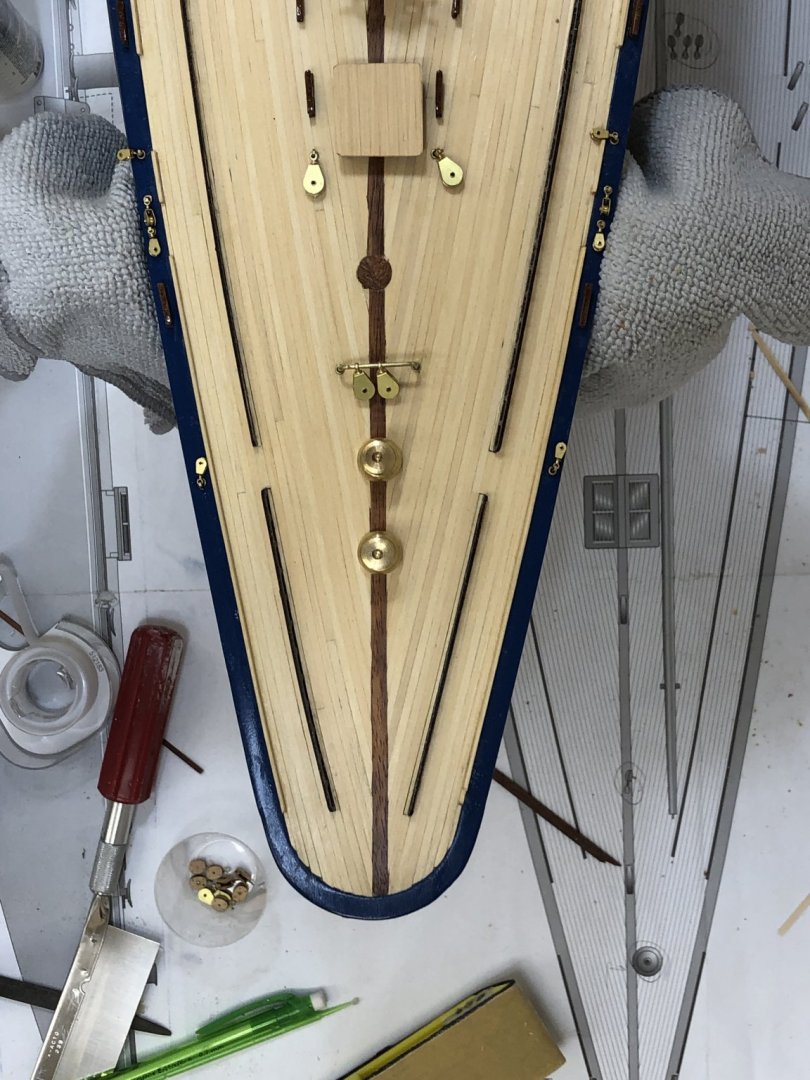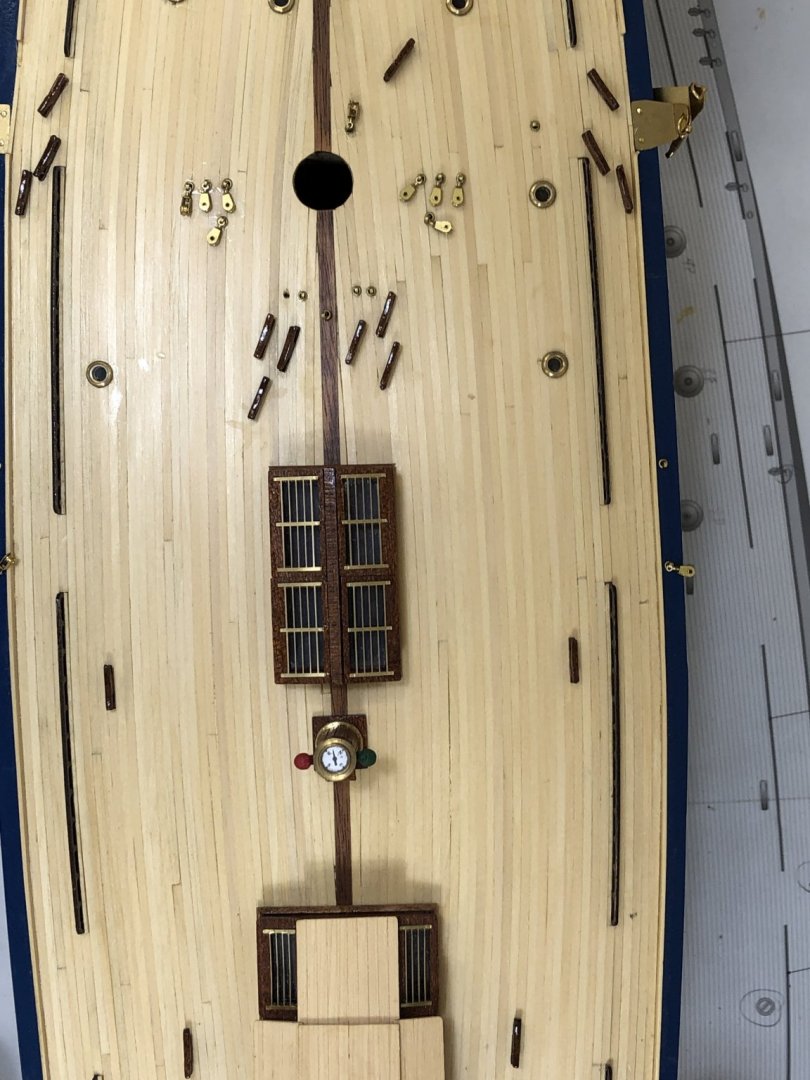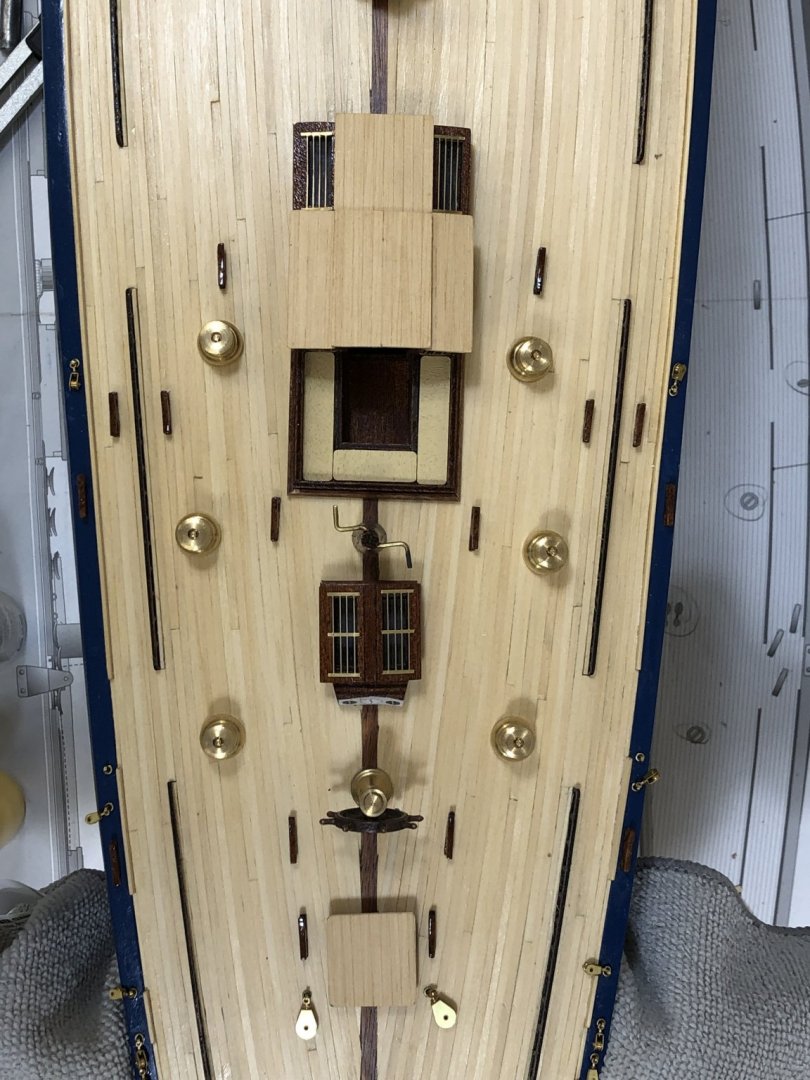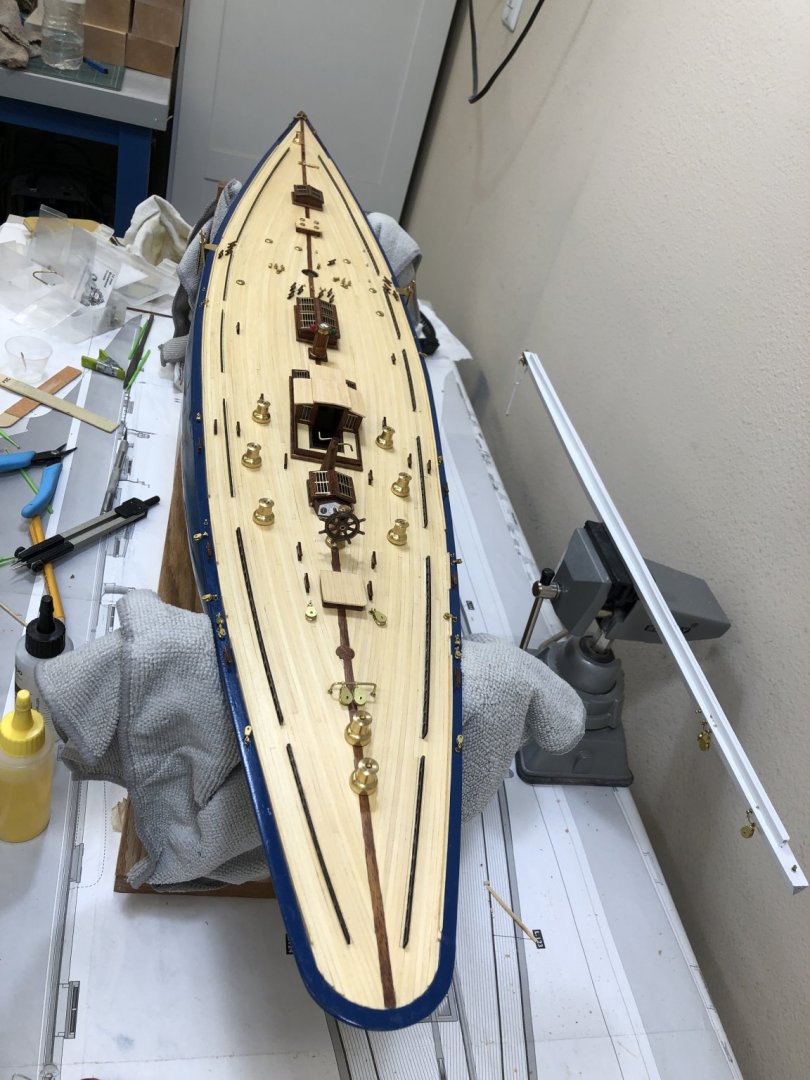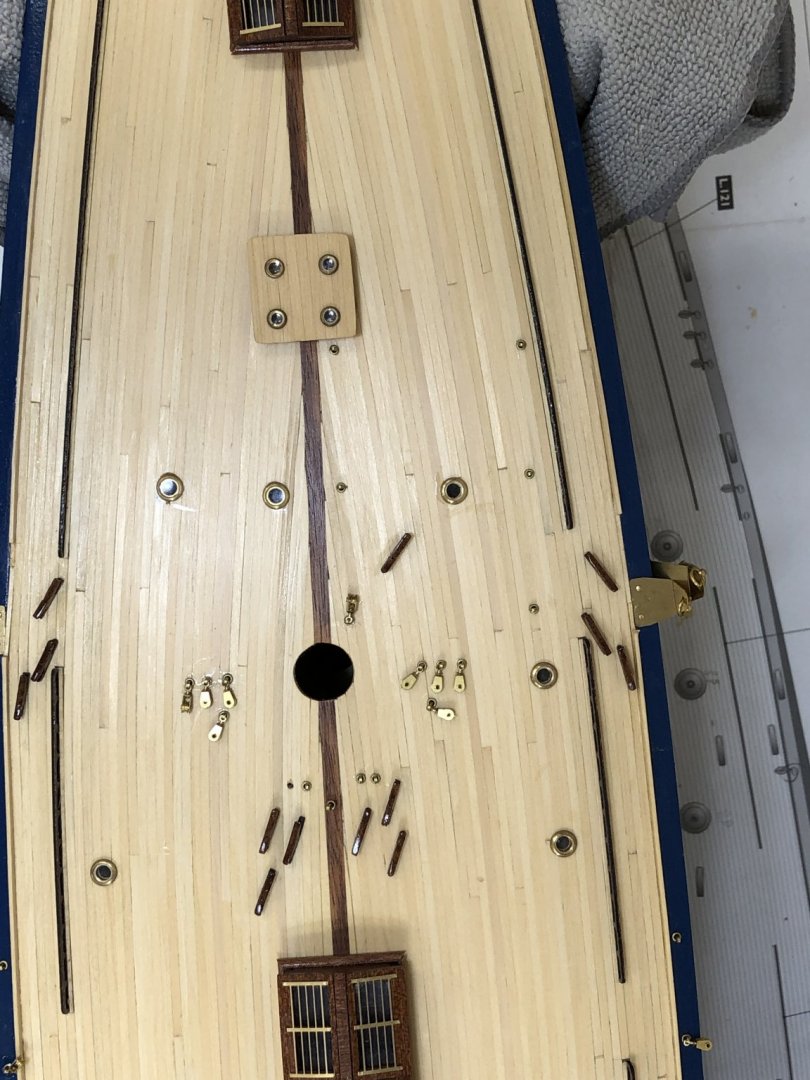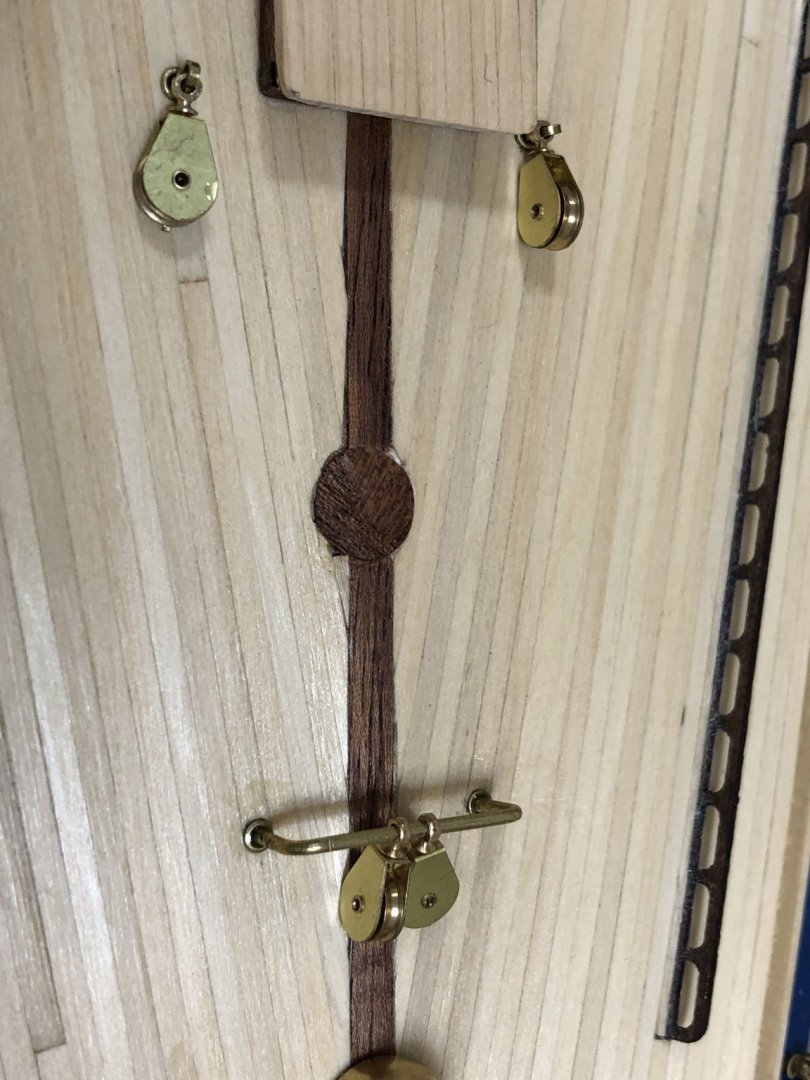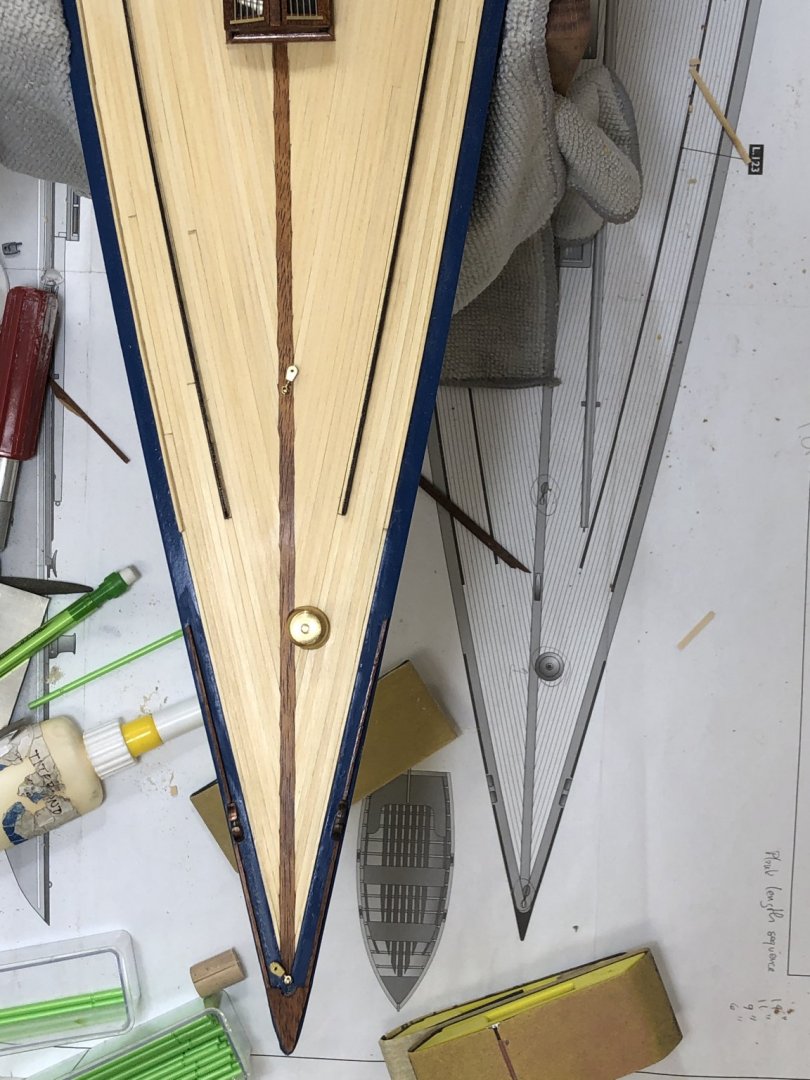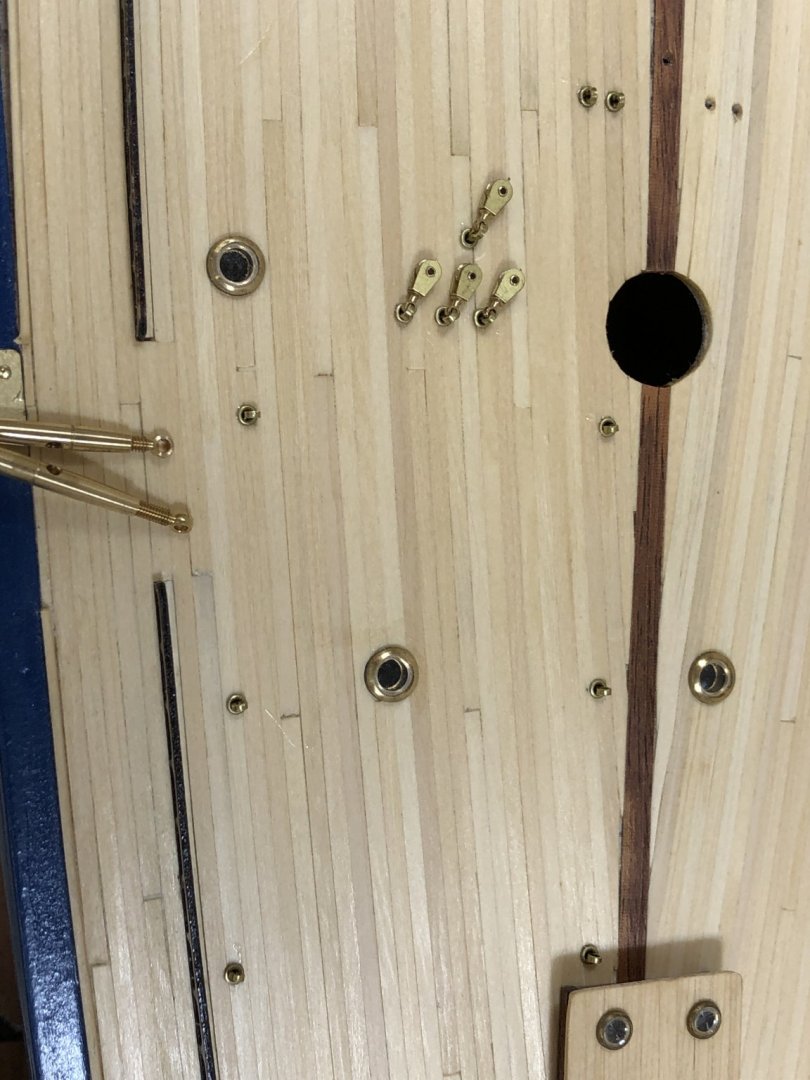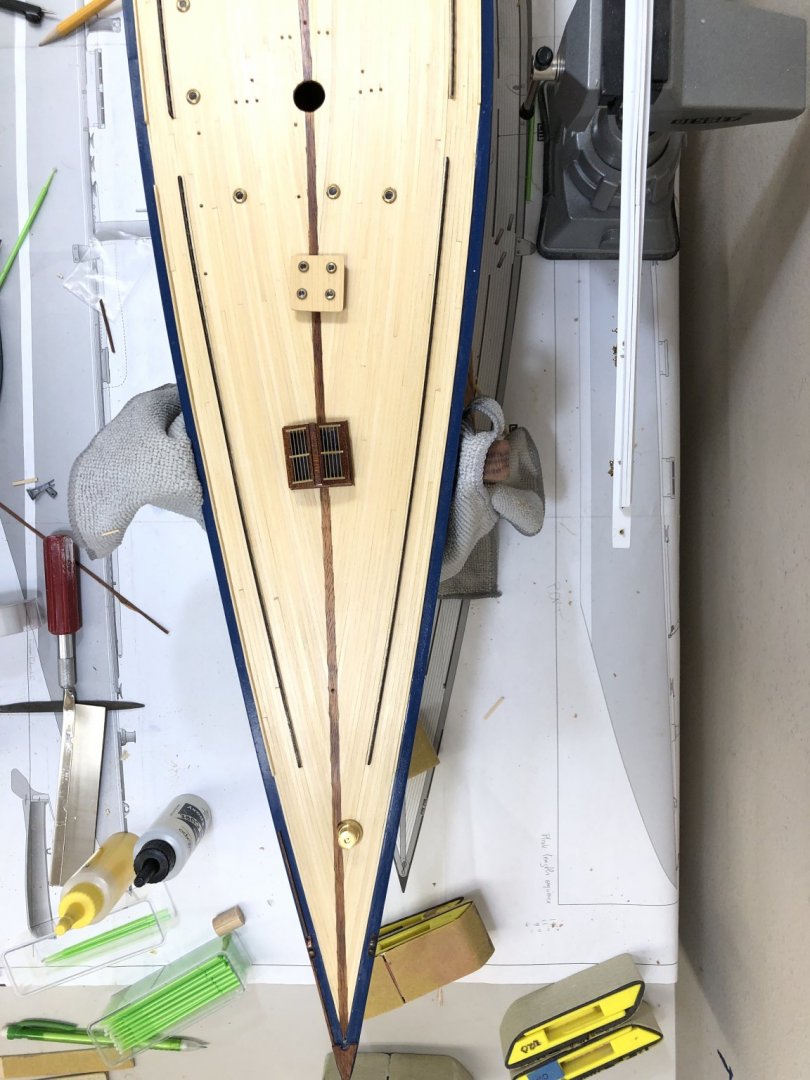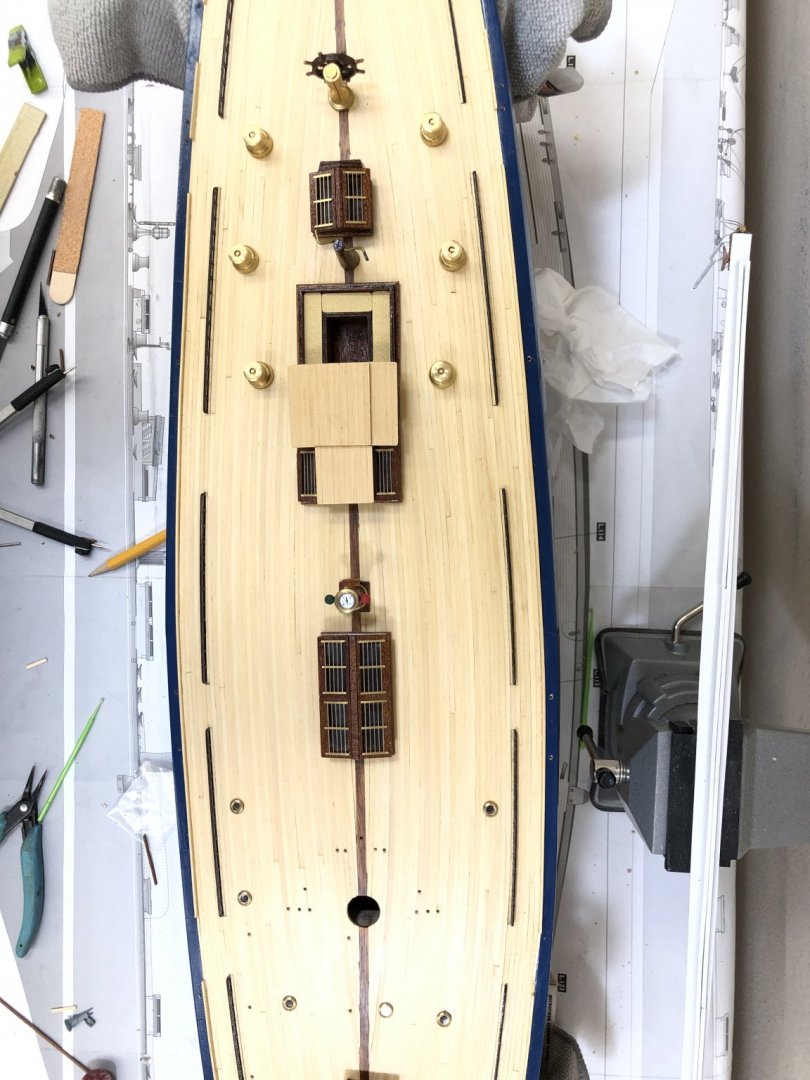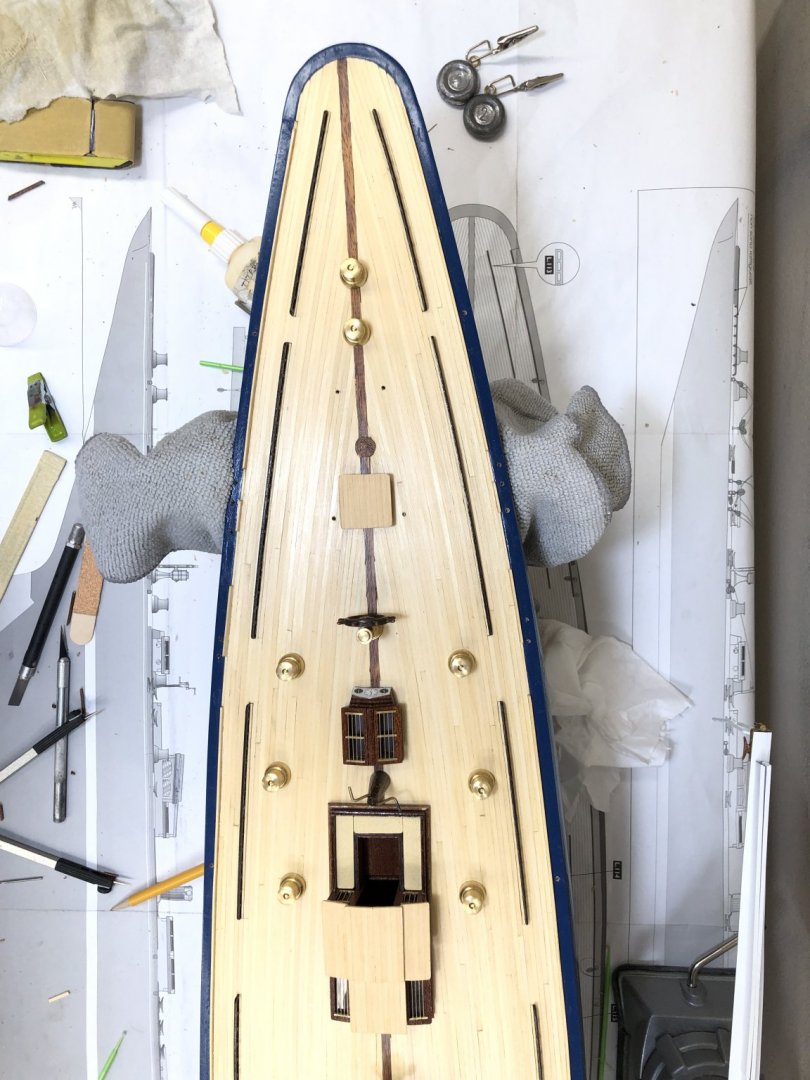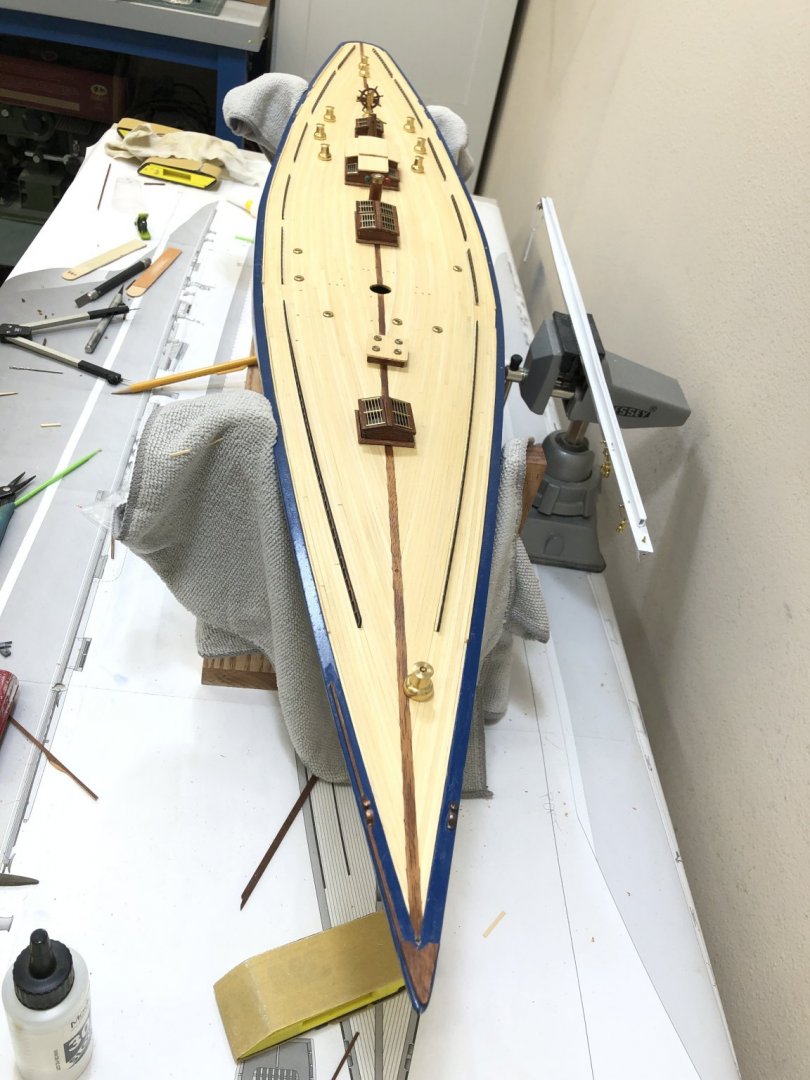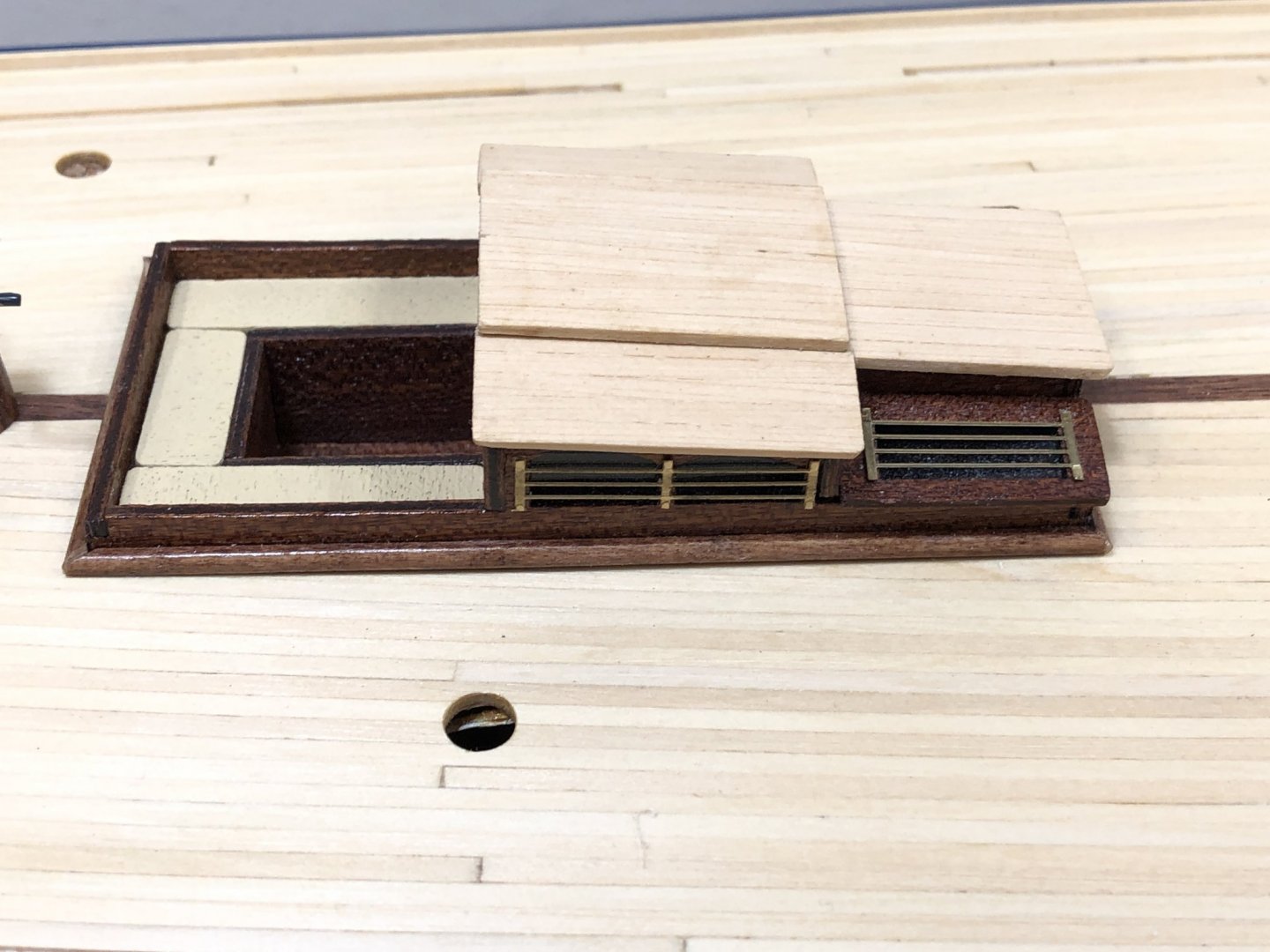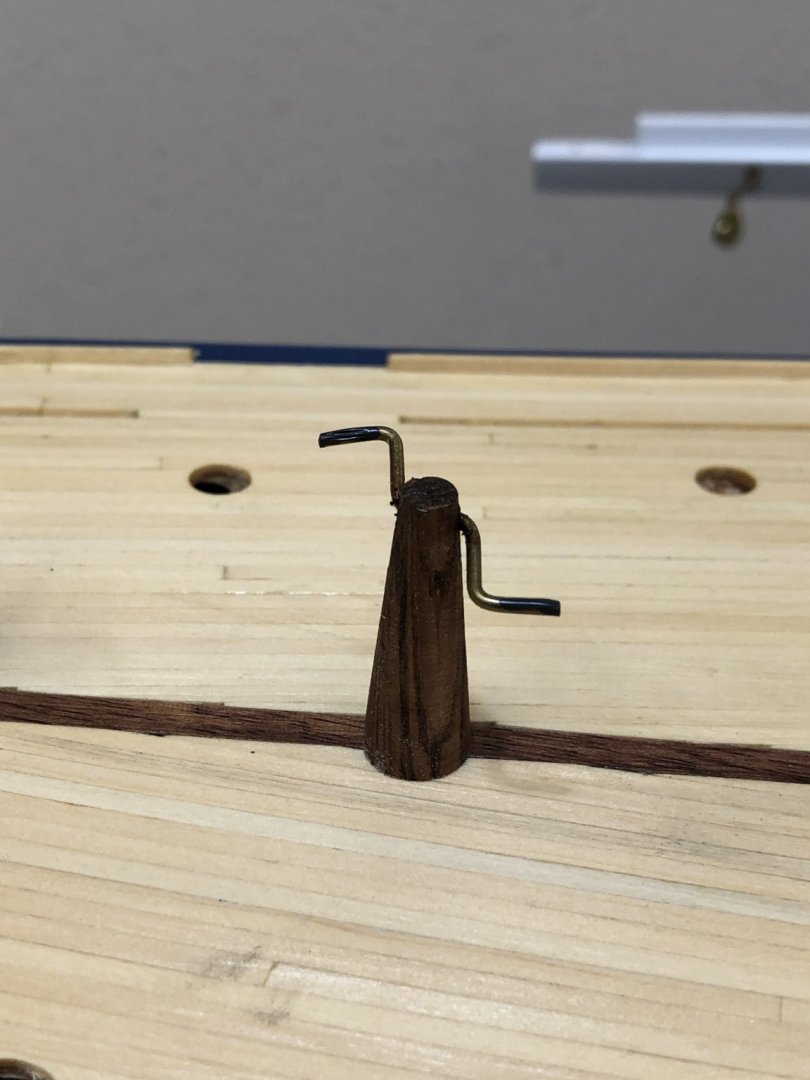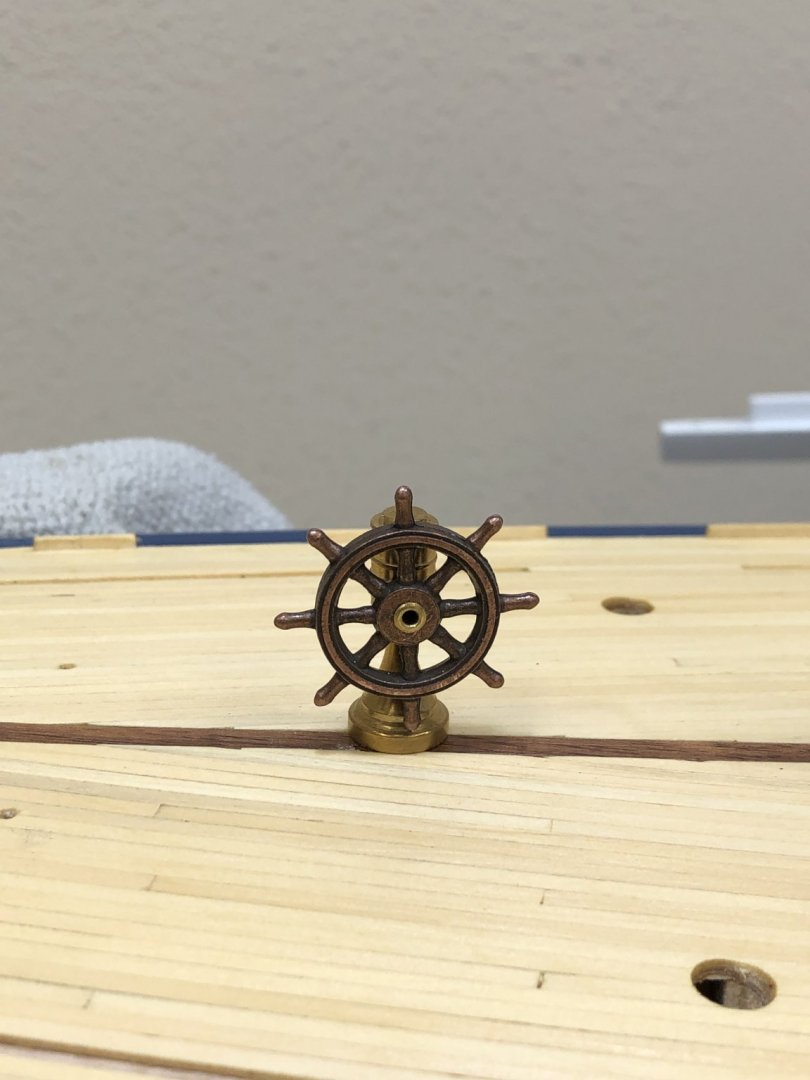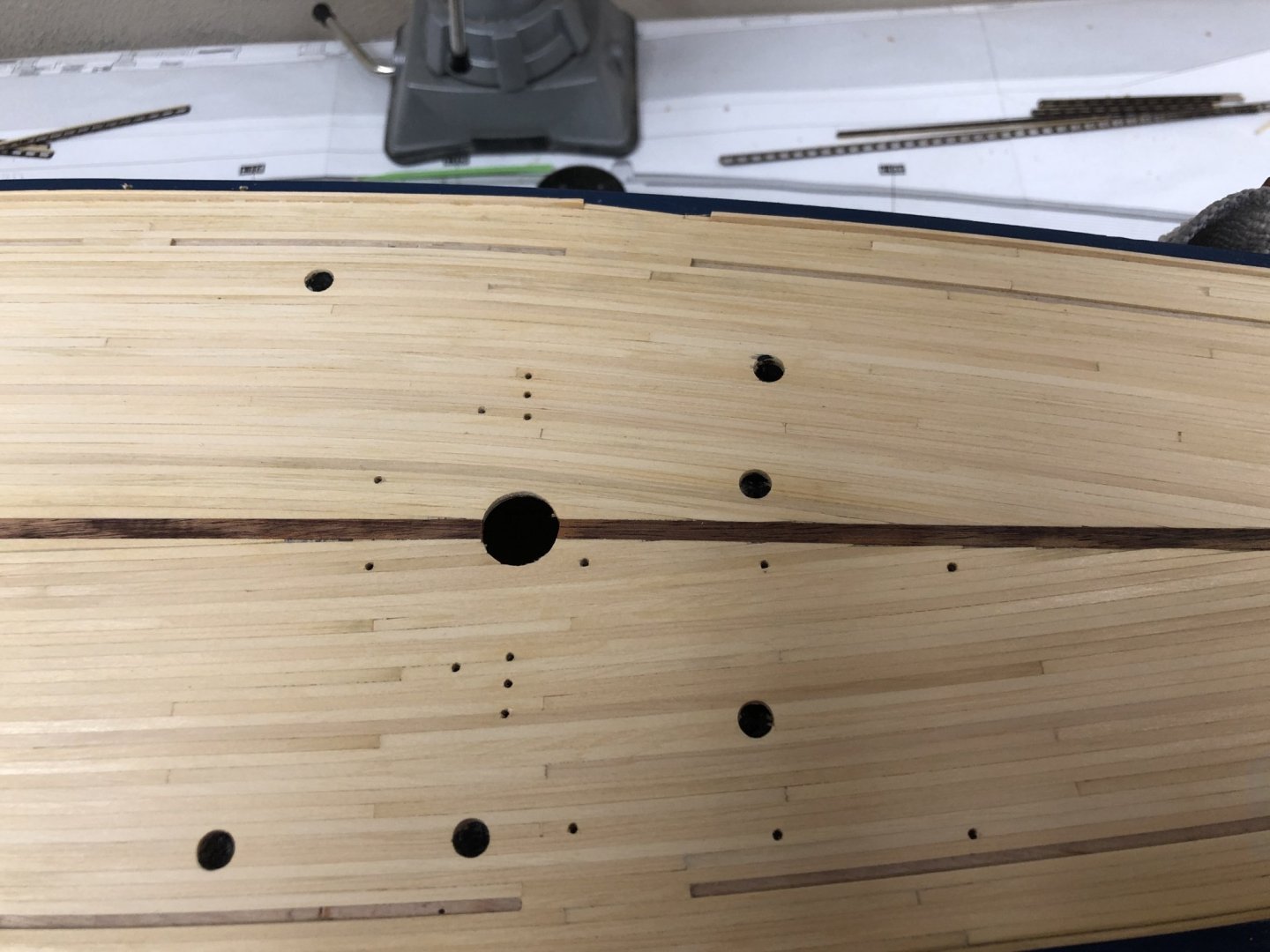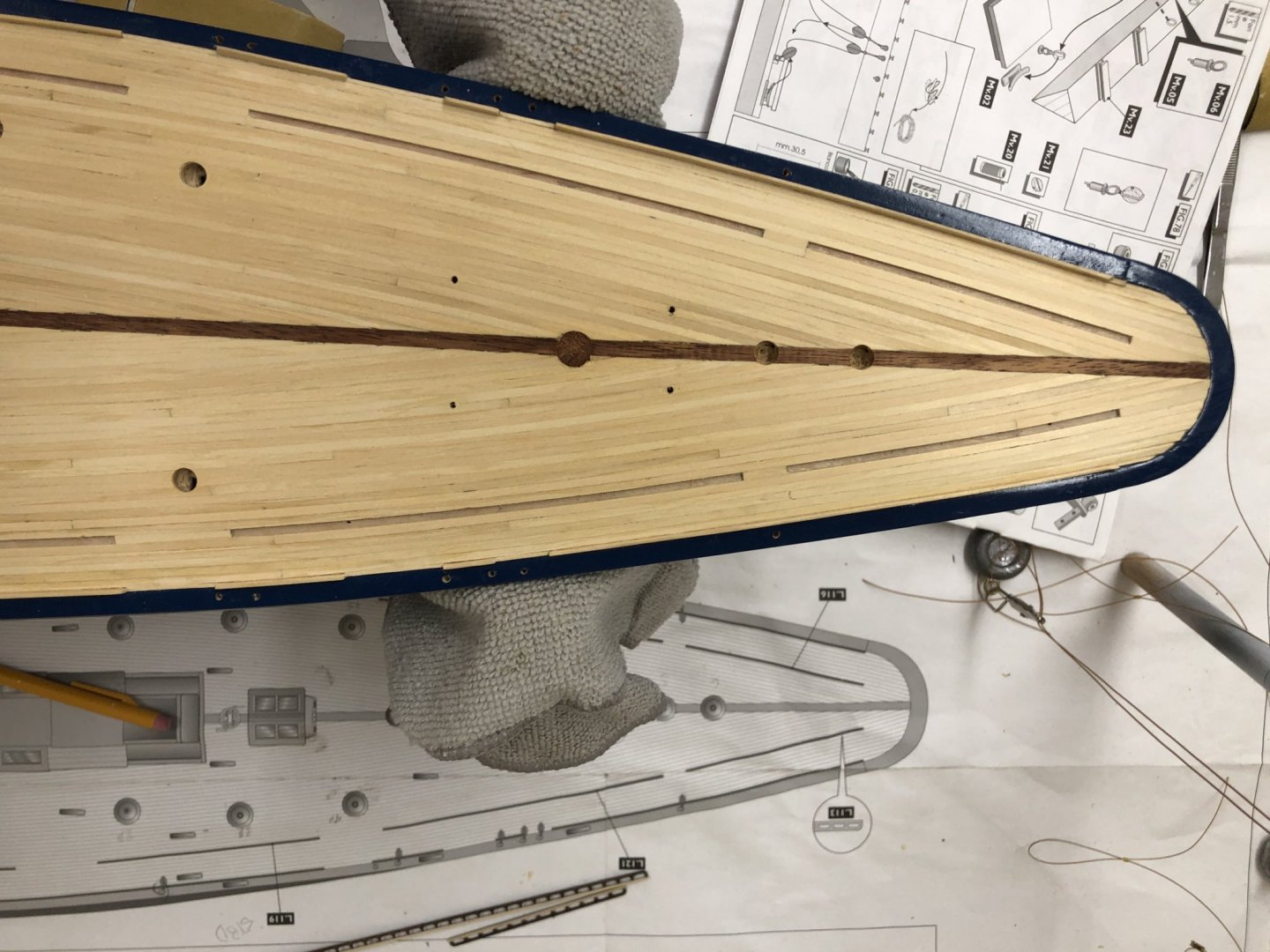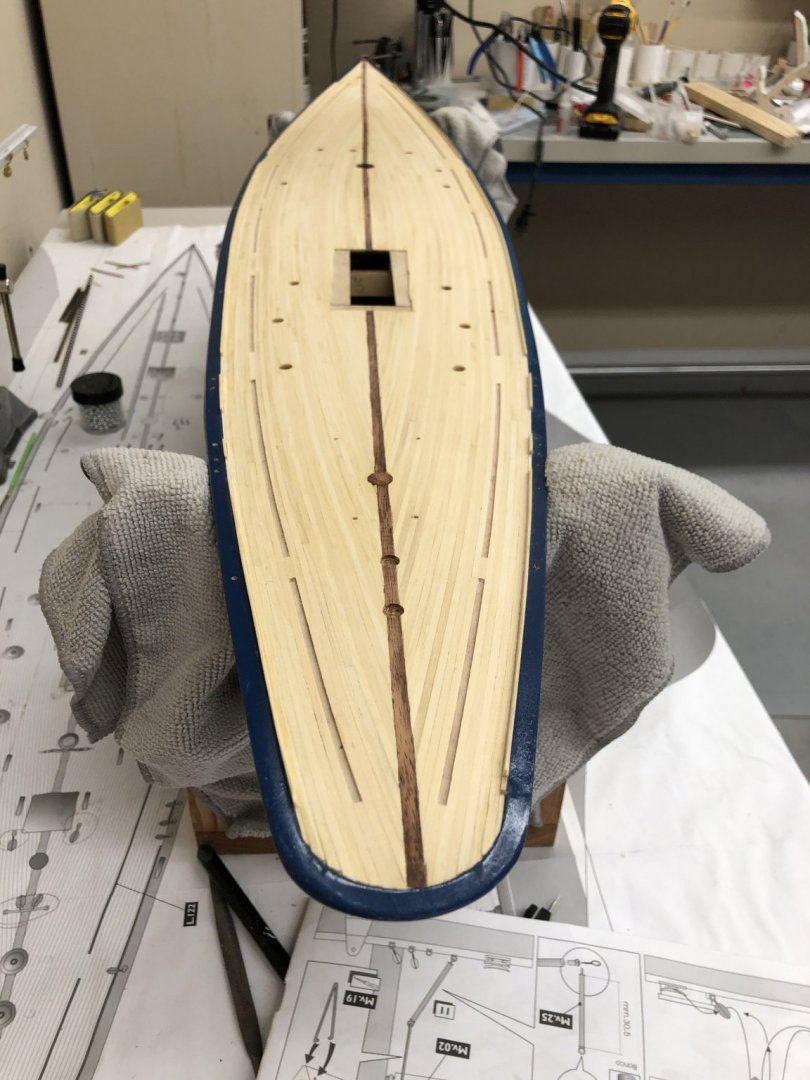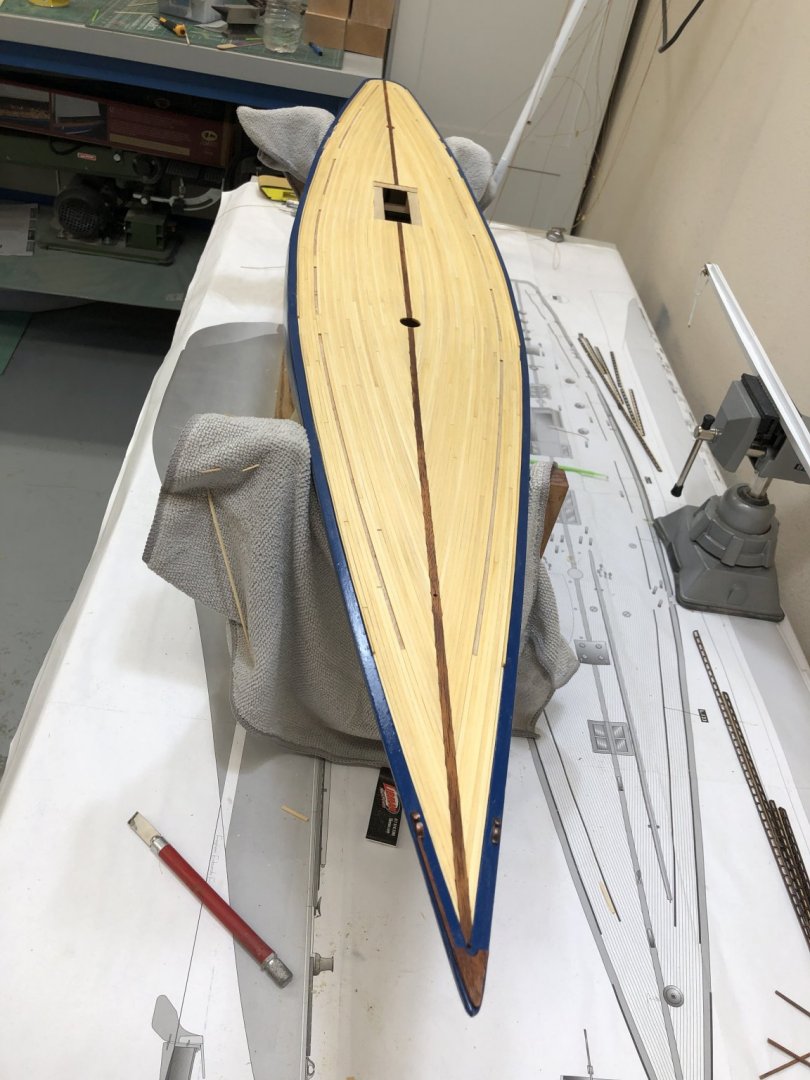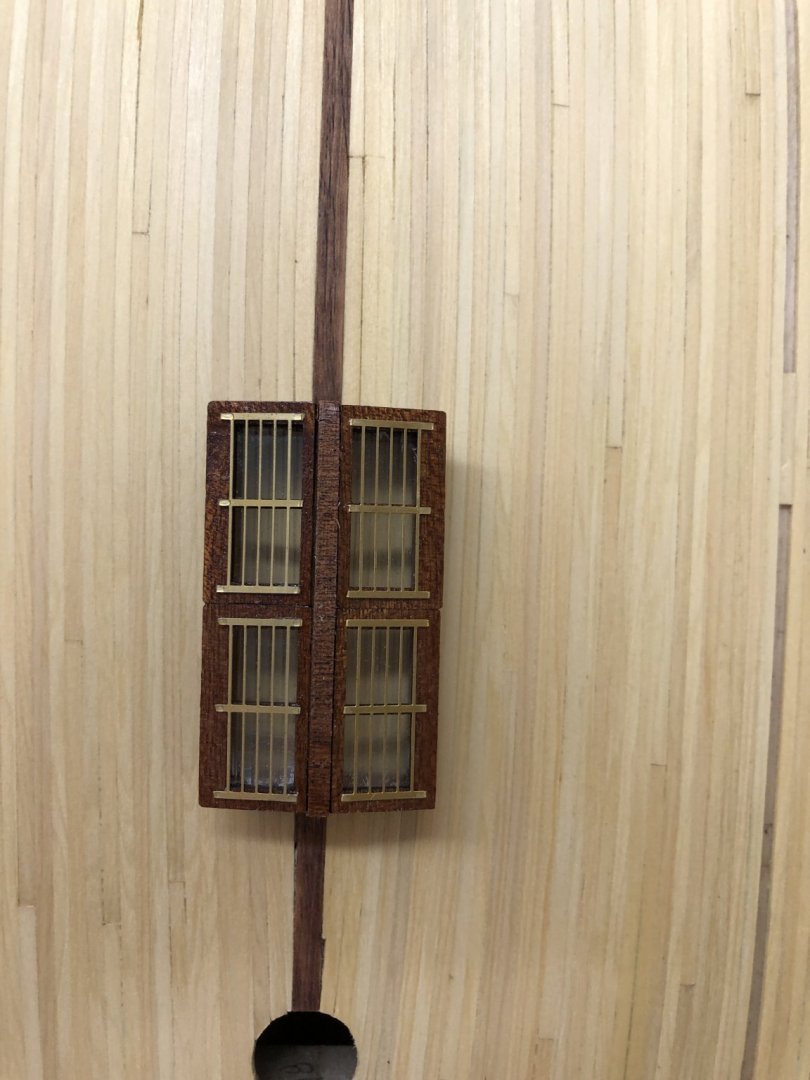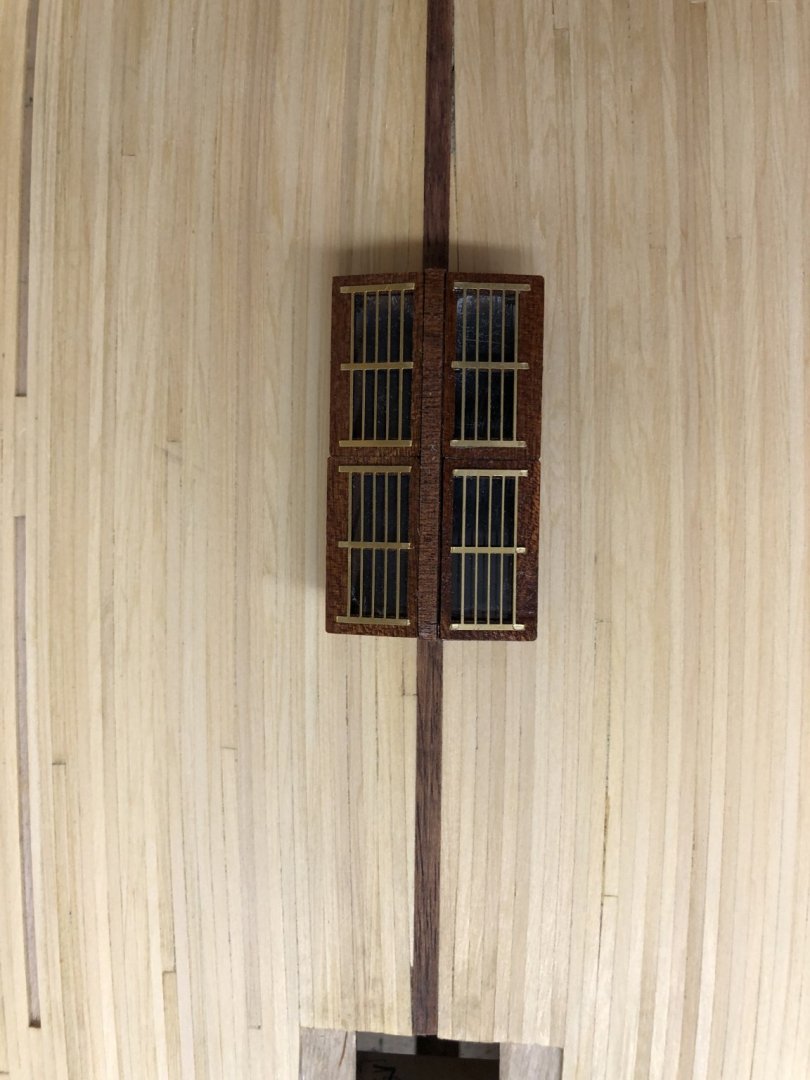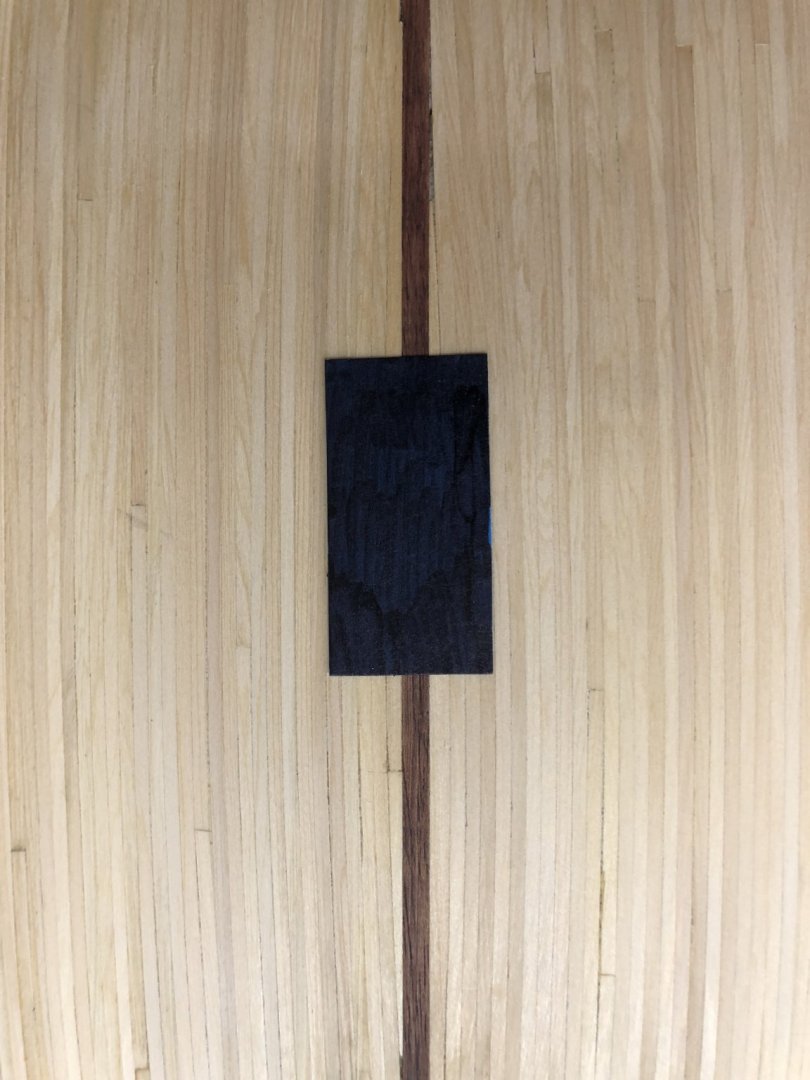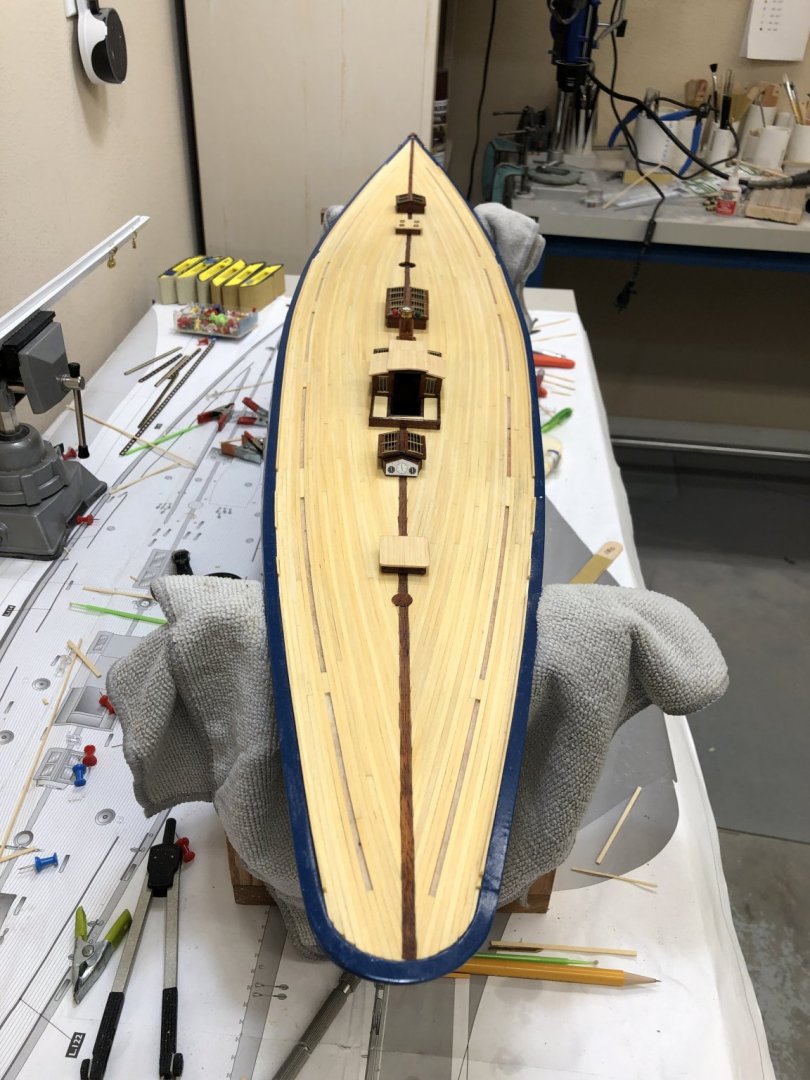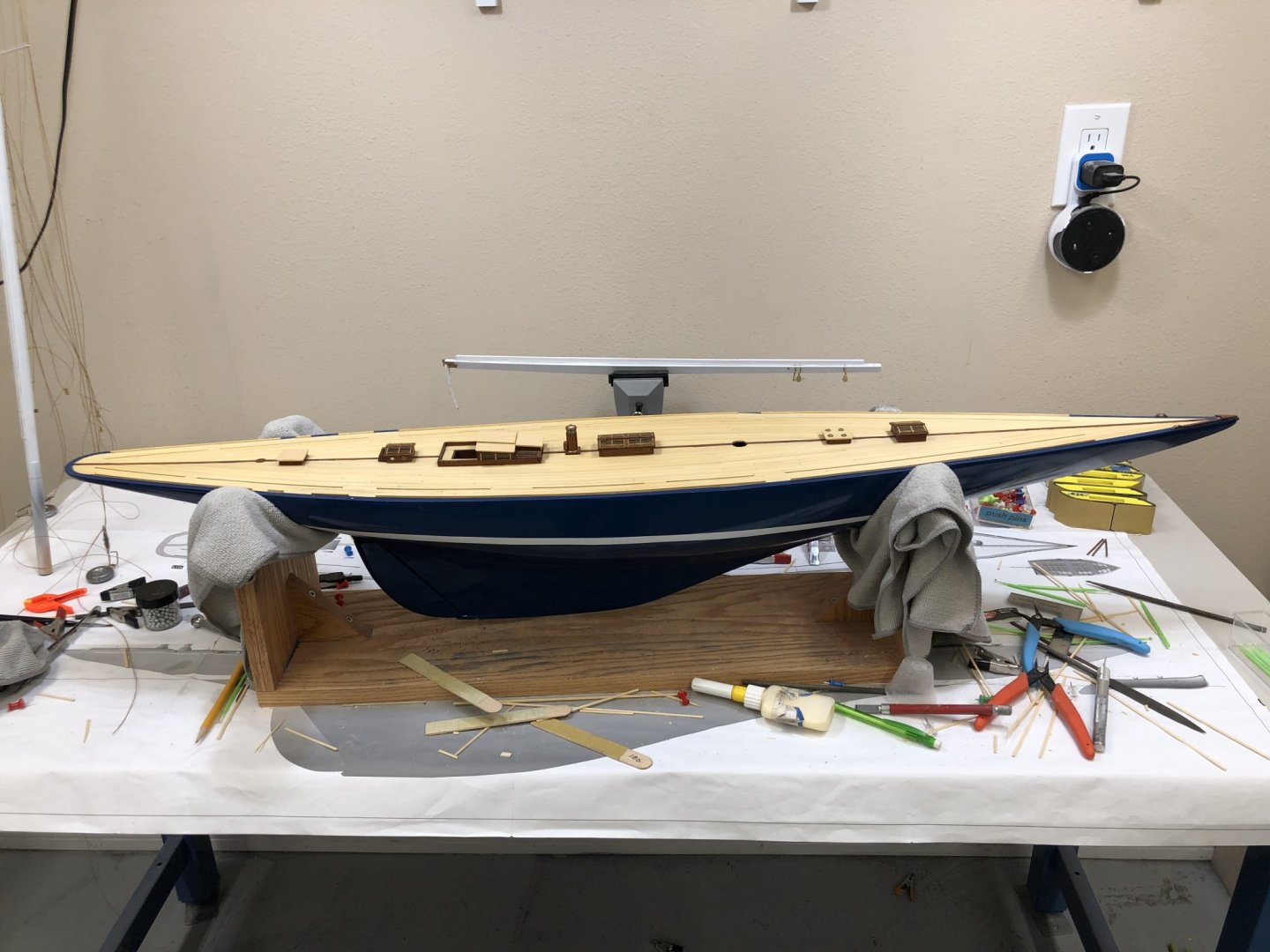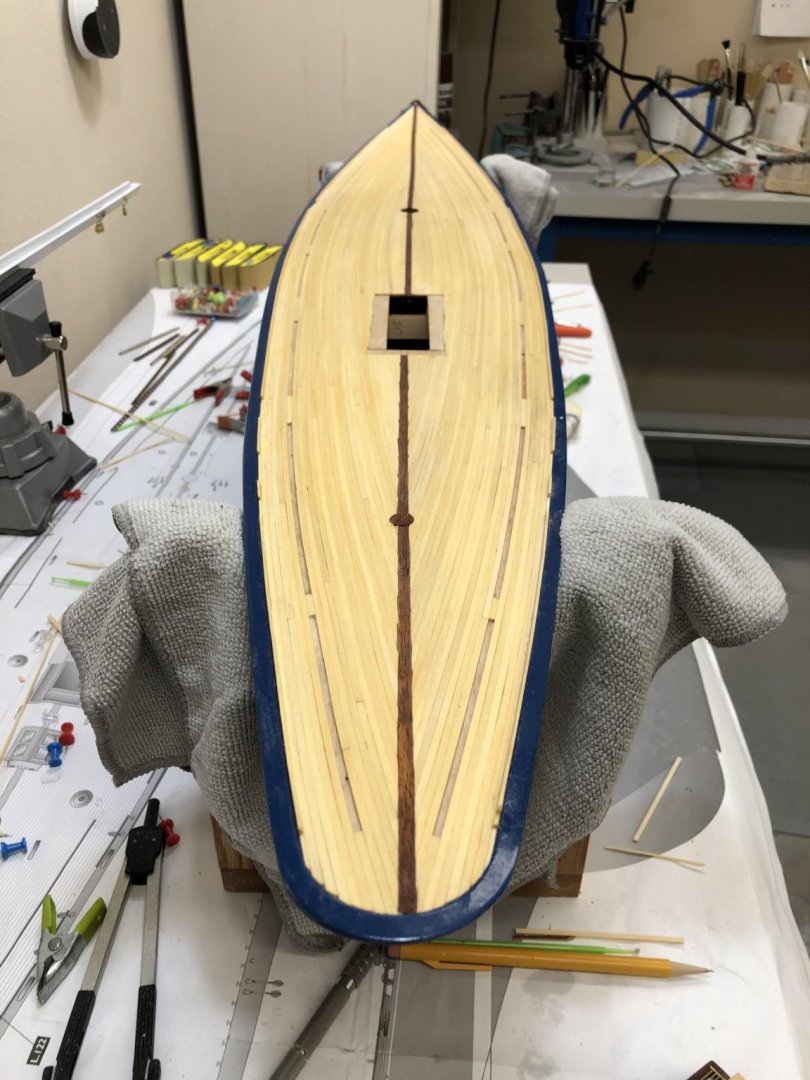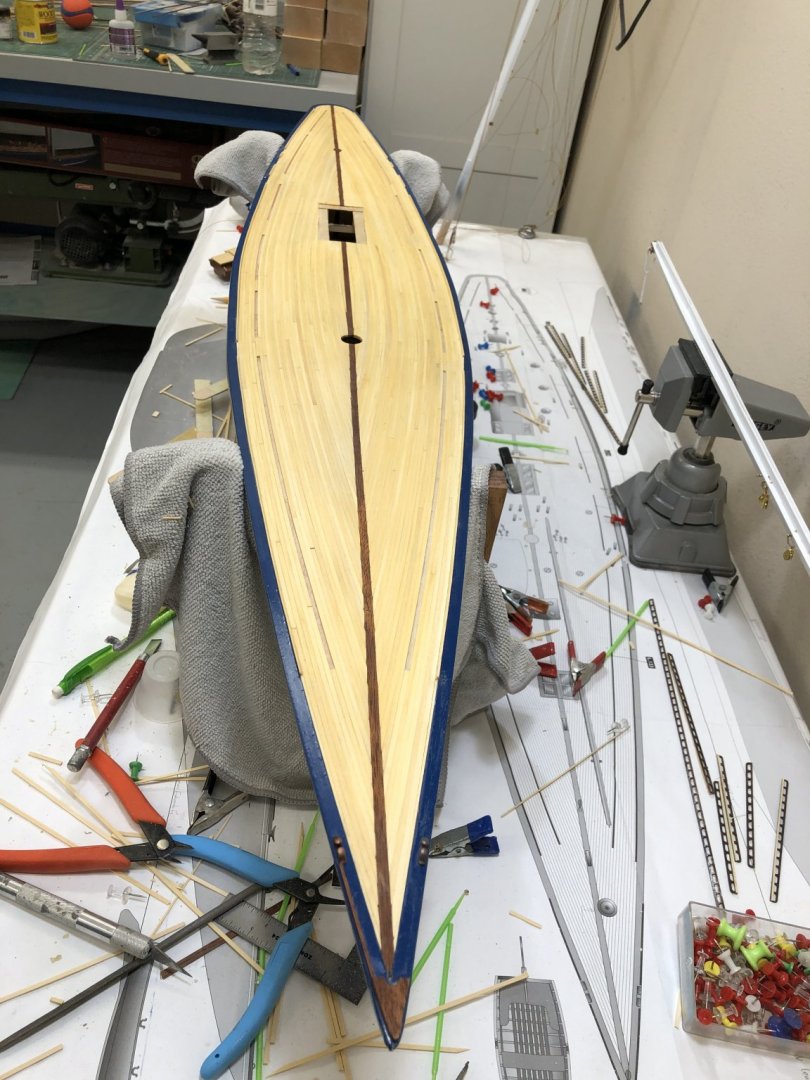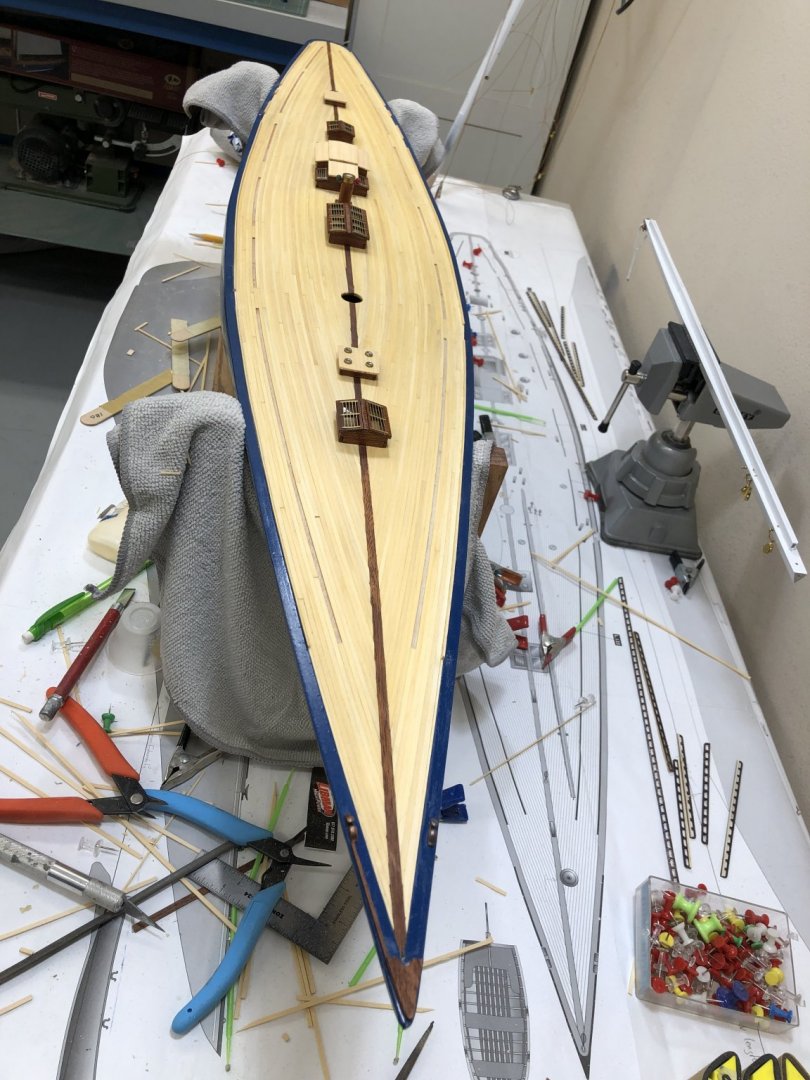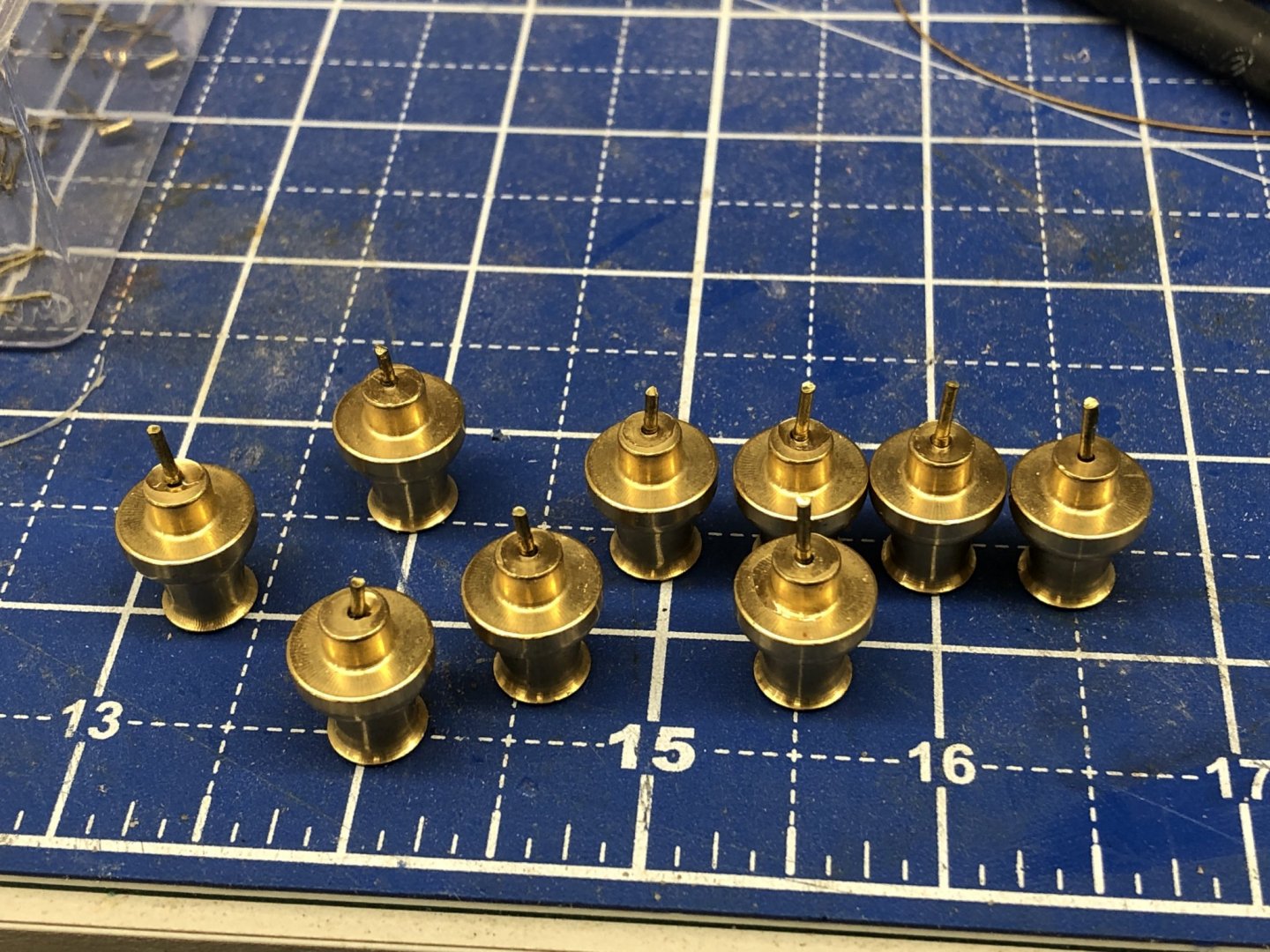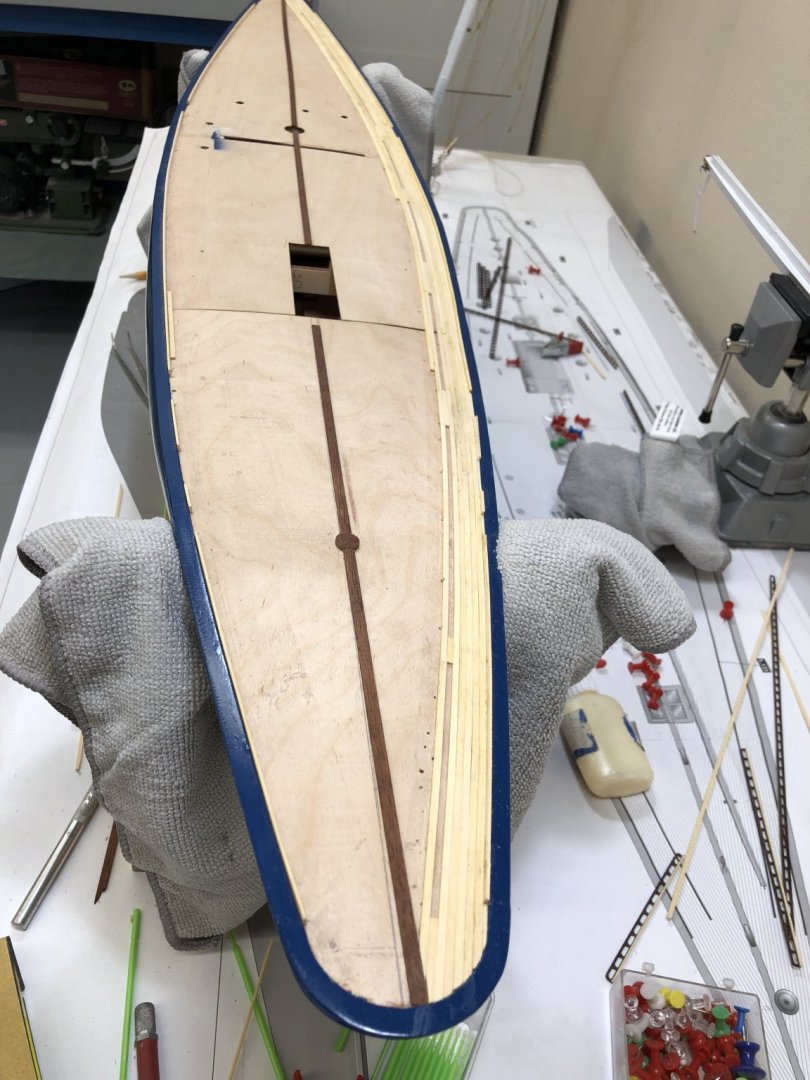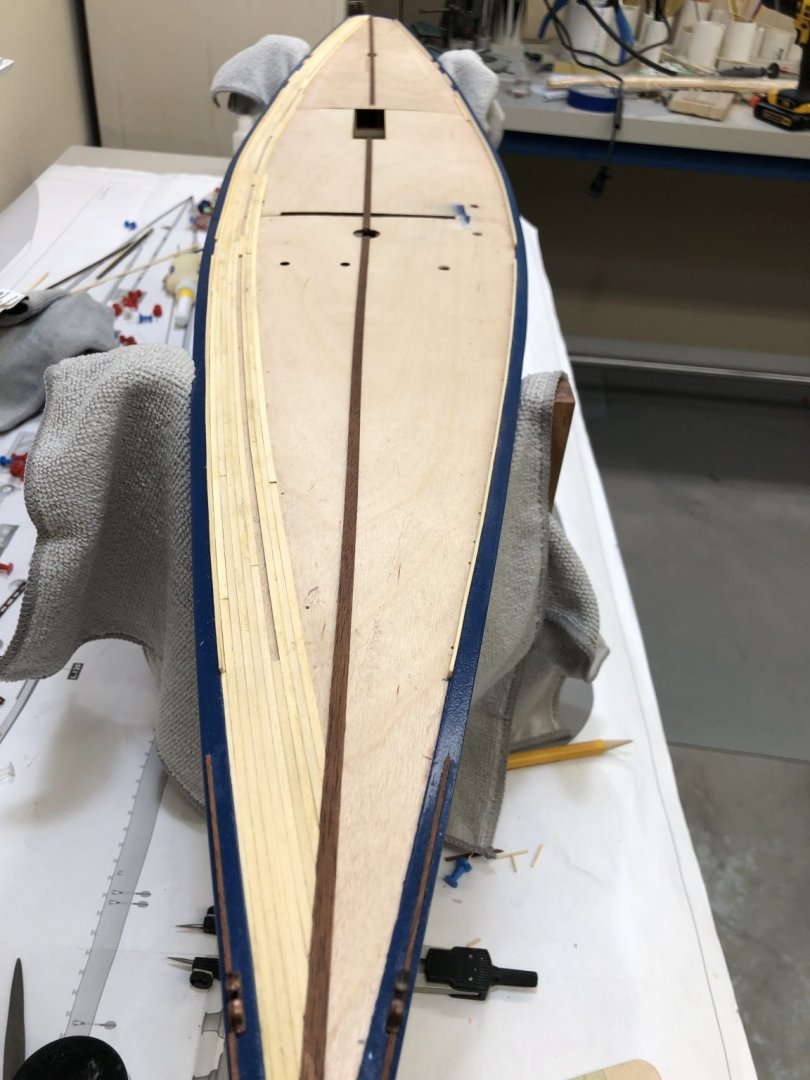-
Posts
1,915 -
Joined
-
Last visited
Content Type
Profiles
Forums
Gallery
Events
Everything posted by cdrusn89
-
After looking at the aft back stay design awhile I decided that having the bitter end of the aft tackle going more or less directly down to the deck edge cleat was not how I wanted to do things. It is much better (IMHO) to have the line going to a cleat such as used here to approach the cleat from more or less the same level as the cleat - i.e. pulling on the cleat in the horizontal plane instead of the vertical. To facilitate this I replaced the aft single block with a double (which I luckily had in my collect of brass blocks). As you can see in the photo below the line comes off the becket, around the deck block, around the becket block, around the deck block again and then forward to the cleat. I am considering changes to the other back stay tackles so they also approach the cleats from deck level not above.
-
While waiting for the varnish on the new cleats to dry I started to get the back stays rigged (as far as possible) without having a place to belay them. This involves getting the pendants to the correct length and rigging the tackles through the appropriate block. Here are the after back stays with the tackle terminated with a clamp suspended over the side to provide a little tension. The bits of blue tape mark the cleats that need to be replaced.
-
In preparation for rigging the running back stays (there are three sets of two) I made up the six tackles that connect the back stay to the hull. I made two of the type on the left and four of the other. The two with a line to both sides of the block (which is barely visible - sorry) are for the after back stay where both ends belay to cleats and there is a single block at the back stay pendant. The other two sets of back stays have the block shown in the picture at the end of the pendant. That all went without difficulty. The problem started when I tried to belay the aft back stay tackle to the indicated cleat. The cleats in question are the after most ones which are mounted outside of the deck "railing". It came free from the hull with very little effort. I had suspected this might be a problem, especially since the force on these cleats is mostly vertical given the way the rigging is configured per the provided drawings. So I decided that I would replace, at a minimum the eight cleats that belay the back stays (the after most set has two cleats per back stay). I took one of the cleats that came off and managed to drill a .040" (#60) hole vertically through the more or less center of the cleat. I got a piece of .039 music wire to use as a pin through the cleat and drilled a #60 hole in the hull to hold the cleat. That example cleat is shown on the left in the picture below. I had so much fun doing that one that I decided to make new cleats with the hole from scratch. I needed seven so I decided to make a few extra in case I encounter this issue with some of the other cleats. There will be a short intermission while I stain and varnish the crop of new cleats.
-
Yves - I am trying to stick with the look as it might have been in the 1930s, so no carbon fiber, white canvas is what I am trying to portray.
-
While pondering how exactly to go about mounting the mast/boom I built frames to hold the material for the three sails. They give you an idea of how BIG the sails will actually be. My girlfriend (the quilt lady) is going to cut out the fabric today (maybe) and I will get them mounted on the frames in preparation for the glue/water mixture to be applied.
-
The deck is "officially" complete. I am still considering some method of adding some additional strength to the cleats that will be under load. Like drilling down through the center and adding a .025" wire with a drop of thin CA to freeze the wire and wood together. I need to let the Titebond set overnight before I do anything. I think there are only a few cleats where they see much if any load. all the jib sheets go to the winches first so the winch takes whatever load there is. The backstays may be where I need to do something as they might be under some tension trying to get the mast aligned correctly. On to building the frames for the sails and getting the mast, boom and standing rigging aboard.
-
I decided to redo the block/eyebolts for the jib stays. I added a small turnbuckle to the block that is there for the jib's downhauls. It was going to be tight getting the jibstays hooked in as it was and now I have the ability to tension the jibstays after the wire is secured. It means that the jib and flying jib will not be positioned as close to the deck as they would have been otherwise but I think that is a price worth paying. I will have to slightly adjust the size of the jibs to account for the slight decrease in length at the luff. I changed out the supplied eyebolt for a bigger one to accommodate the turnbuckle.
-
Finished gluing the big pieces an d started on the blocks, eyebolts and chain plates. hope to finish the deck hardware today and start working on the frames for the sails tomorrow. Here are the stbd chain plates and the blocks and eyebolts on the stbd side forward. I moved the out chain plate a b it forward of the inner so the rings holding the turnbuckle do not interfere with the chain plate. The blocks, eyebolts and chain plates are attached with epoxy so hopefully they will not be pulled out when tensioned.
-
I finished placing (although not all are glued in place just yet - for instance the forward hatch with the four skylights) all of the major deck furniture and other topside items except the whisker pole, eyebolts, blocks "chain plates" and cleats. Here is how it looks now.
-
More odds and ends. I decided to add a molding around the base of the cockpit and the skylights. I find it hard to believe that these were not included as it would be really hard to keep a vertical seam between the deck and structure anything close to watertight without something to force the caulking into the seam. Maybe they were eliminated to save weight and let the crew man the pumps to keep up with the entering water and be miserable below decks. I assume they had to sail this across the Atlantic to try for the cup (no heavy lift ships in the 1930s) but maybe it was towed or carried over as deck cargo. Anyway it gave an excuse to try out one of the draw plates I got from Artesania via Hobby Tools. I used the 2mm X 2mm quarter round slot (upper left) which would be not quite 3" - pretty big but it is the smallest I have.. I used a 3/32 x 3/32 boxwood piece thickness sanded to 2mm x 2mm. It worked pretty smoothly and reasonably fast - although I would not like to have to make 20' of it this was. I mounted the wind instruments prior to painting. I might have gotten carried away on these. The vane would be about 3' long at scale but it is way up there although I am sure they had a readout on deck (there are some gauges on the aft skylight structure just in front of the helm). I have decided to mount a pair of smaller winches (from Bluejackets) on each side of the mast near the deck. There does not appear to be a method for tensioning (or securing) the main halyard (the instruction show an eye in one of the sail tracks with what is apparently a weight on the end as the termination of the main halyard). On a modern sailboat there is a winch located about 3-4 feet above the deck and this is used to tension the main halyard and it secures to a cleat below the winch on the mast of through a fairlead block at the base of the mast to a cleat on deck. I am going to replicate these on both sides of the mast, for the main and either of the jib halyards.
-
Gerty - Thanks. Working odds and ends now. Here is a picture of my replacement winch grinder. Not very elegant but it should get the job done. Also put the ship's wheel together - all the parts were there and unbroken too. Also this is the beginning of my anemometer that will go at the top of the mast. It will be painted white and I am hoping no one notices that the cups on the end are not hollow. I used some jewelry beads that I filed down to a hemisphere (more or less) but the only way I could get them to stay on the arm was to glue them on both ends so the arm extends through the "cup" and pretty well fills it up. Maybe I can put a spot of black paint in the center of each one. It will be at the top of the mast in any event and not exactly in the normal line of sight unless you are 7'6" tall. Sorry picture of the more finished anemometer will not load. I will get another picture when it is painted.
-
Three coats of Wipe-on-Poly satin. 24 hrs to fully dry and it is on to deck furniture and rigging installation.
-
You would think that having built five previous model kits I would have checked out all the materials and pieces provided to make sure I had everything and nothing was broken. If you thought that you would be wrong in this particular case. I failed to thoroughly check the "special" pieces provided in this case the winch pedestal. I found it, still inside the packaging envelope in two pieces. Since it is "Britannia metal" (or something similar) and the break is at the thinnest point (where else?) I see no easy way to repair this piece. So I used my new drill press as a poor man's lathe and turned a piece of dowel into approximately the shape and length of the kit supplied part. I am trying to decide now whether to flatten the sides on the top or "quit while I am ahead" and just drill a hole for the handles, stain Mahogany, varnish and call it a day.
-
I got all the holes drilled for the eyebolts, blocks and main sheet traveler (winches and skylights were done earlier. I painted the inside of the skylight holes black to match the blackened file folder in the bottom of the skylight structures. I did another sanding with 320 grit and wiped down with paint thinner soaked rag and now I should be ready for a first coat of Wipe-on-Poly in the morning. I guess I am going to have to get serious about making the sails as I should have the hull and rigging finished in the near future.
-
HQ approves and not one to allow time for additional consideration I managed to locate a suitable drill press locally, procured, set up and drilled the required 15 holes in a little more than five hours, including an hour each way to get the drill press. Worked like a charm and now I only have to find a place for it in the workshop. It is too heavy (almost 100 lbs according to the box) to move around much. It may just have to stay where it is until I need that space for something else, then maybe in the corner somewhere. Here is a picture of the hull on the drill press table and the deck with the winches and skylights sitting in place.
-
Jonathan - that is Alaskan Yellow Cedar from Syren Ship Model Company. It is sold in 14" X 2" "slabs" in your choice of thicknesses. I had to rip and then thickness sand the pieces into 1mm X 2mm planks. Not too much of a problem if you have the right tools. And the glue was Titebond Original.
-
Final sanding (320 grit) and rub down with paint thinner completed. Now the question is apply finish and then drill mounting holes for eyebolts, skylights, winches, blocks, sheet traveler or do that now and then apply finish. Speaking of skylights (the six round ones in the deck) as I was planking over the holes in the subdeck I wondered if the recessed skylights should have been glued down and then planked around. If not then why have the holes in the subdeck. But careful examination of the supplies skylights shows a 15/64" (6mm) diameter "shoulder" on the skylight with a sloped surface above which would have been very difficult to plank around since there is nothing "solid" to which to plank. At that time I decided to plank over the holes and relocate the skylight locations after planking - not that there exact locations are in any way critical. So now how to drill the appropriate holes to mount both the skylights and the winches. Luckily both have mounting shoulders the same 6mm in diameter. Short of buying a 6mm drill bit the next largest size English bit would be 1/4". Luckily Forstner and quill point drill bits are readily available in this size. My set only goes down to 5/16" but Amazon delivers tomorrow with a 1/4" Frostner which I think would be the tool of choice to drill into the deck since the hole will cross at least three strips of planking. Hopefully I glued them down really well and the drilling will not tear them up. Now to decide if my cordless drill is to weapon of choice or do I need a larger bench drill press that would allow the entire hull to be mounted under it. Both my "model" drill presses are too small to get the hull under. I have to consult with HQ about this subject. You have to have the right tools! So, given the possibility that there could be deck damage from drilling the installation holes (at least for the deck skylights and winches) I will wait until they are done before applying the finish to the deck.
-
While I had the deck furniture on the deck I noticed that it was pretty noticeable that what was under the skylights was just the deck. Clearly that is not the effect I am after so I cut some pieces of a file folder and blackened them with a magic marker and fit them under the skylights. Here is a before and after of the lrge midships mskylight.
-
Deck planking completed and first sanding (120 grit) completed. Second half went pretty much like the first except it was n ot quite as symmetrical. I had to create a piece tapered on both ends where it came together at the centerline amidships. On the stbd side it was only tapered on one end. It appears that I either did not get the centerline piece in the center aft of the cockpit (it never occurred to me to use the laser level to help with this) or something else is badly off as the handrail is clearly closer to the centerline board on the stbd side than of the port. Not much I can do about it now (or while I was planking the deck) so I will have to live with it. If I had it to do over I would follow Keith Aug's example and make the centerline plank a nibbing strake. Because of the shallow angle the deck plank have approaching the centerline it is very hard to get the plank to a sharp enough point (and the correct angle) to completely fill the space. If you look at the photos you can see that it has the nibbling strake look, just on a really small scale. So here are some shots, with and without the deck furniture which I have finished after a rub down with a paint thinner soaked rag which is pretty close to how it will look after the finish sanding and Wipe-on-Poly satin which is what I intend to use.
-
Yea, I guess if I had looked at the drawing a little more carefully I would have seen that the flared base and up is the part above the deck. Oh well, no harm except a few wasted minutes.
-
While waiting for glue to set up I decided that the winches needed something to help locate them - especially on what will be the varnished deck. So I drilled a hole in the center (hopefully) and glued min a 3/64" brass rod. Some are not as straight as I would like but I plan on drilling the hole in the deck somewhat oversize so hopefully this will not present too much of a problem. I tried #56 and #57 bits for the hole and the #57 was too small and the #56 a bit too big even though 3/64s would be between a #56 and #55 according to my drill size chart. Oh well.
-
Starboard side deck planking complete - Yikes there is a lot of deck to plank. If I had it to do over I might use a little wider planks - 2mm seems to take forever - and that was only the half of it. Waiting to sand until both sides are done.
-
All the handrail "slots" completed on the starboard side. On the port side I am thinking about just gluing the 1mm X 1mm fillers onto the deck rather than onto the handrails. Not sure which is the easier way to go. Getting the filler pieces on the handrails was not that easy - not hard to get them misaligned. I have some time to think about it - Starboard side isn't half done yet.
About us
Modelshipworld - Advancing Ship Modeling through Research
SSL Secured
Your security is important for us so this Website is SSL-Secured
NRG Mailing Address
Nautical Research Guild
237 South Lincoln Street
Westmont IL, 60559-1917
Model Ship World ® and the MSW logo are Registered Trademarks, and belong to the Nautical Research Guild (United States Patent and Trademark Office: No. 6,929,264 & No. 6,929,274, registered Dec. 20, 2022)
Helpful Links
About the NRG
If you enjoy building ship models that are historically accurate as well as beautiful, then The Nautical Research Guild (NRG) is just right for you.
The Guild is a non-profit educational organization whose mission is to “Advance Ship Modeling Through Research”. We provide support to our members in their efforts to raise the quality of their model ships.
The Nautical Research Guild has published our world-renowned quarterly magazine, The Nautical Research Journal, since 1955. The pages of the Journal are full of articles by accomplished ship modelers who show you how they create those exquisite details on their models, and by maritime historians who show you the correct details to build. The Journal is available in both print and digital editions. Go to the NRG web site (www.thenrg.org) to download a complimentary digital copy of the Journal. The NRG also publishes plan sets, books and compilations of back issues of the Journal and the former Ships in Scale and Model Ship Builder magazines.








